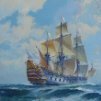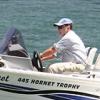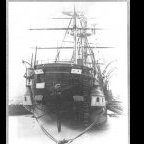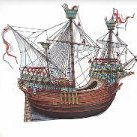Supplies of the Ship Modeler's Handbook are running out. Get your copy NOW before they are gone! Click on photo to order.
×
-
Posts
8,149 -
Joined
-
Last visited
Reputation Activity
-

-
 allanyed got a reaction from bruce d in 21 ft Yawl Longboat for a Sixth Rate by vaddoc - FINISHED - Scale 1:10 - Plans from the National Maritime Museum
allanyed got a reaction from bruce d in 21 ft Yawl Longboat for a Sixth Rate by vaddoc - FINISHED - Scale 1:10 - Plans from the National Maritime Museum
She is a beautiful model! Your planking was done so well that I am sad to see paint covering your great work.
Allan
-

-
 allanyed reacted to druxey in Chisel hone guide question
allanyed reacted to druxey in Chisel hone guide question
I cut a series of grooves using the gouges and veiners in a piece of softwood, then load the grooves with green honing compound. Cheap!
-
 allanyed got a reaction from Bill Morrison in HMS Diana 1794 by newbee - Caldercraft - 1/64
allanyed got a reaction from Bill Morrison in HMS Diana 1794 by newbee - Caldercraft - 1/64
NB
Using filler blocks is a wise move. If you have not already studied it, the contemporary model at RMG may be of some help not to mention the plans they have of Diana 1794. Note that as she is post 1790, she does not carry her name on the stern which was by Admiralty orders (maybe not universally adhered to😀)
https://www.rmg.co.uk/collections/objects/rmgc-object-66303
-
 allanyed got a reaction from hornet in What are ground toes?
allanyed got a reaction from hornet in What are ground toes?
Thanks for the feedback everyone.
Craig, I know of TOCS but only in the sense of modern terms, the theory of constraints which is a management paradigm😁 Looking further at the "c's" and "e's" in the contract, it could very well be toc versus toe. Either way I am at a loss. It sounds like flying is new stuff and ground is used material which makes sense, but what exactly is toe, toc, tow? It really is not an issue for our model scales, but I did find it to be an interesting item none the less.
Dean,
To me the word looks nothing like tow, BUT, you may be right based on what I found when looking up TOW. MIddle English - touw from Old English tow (“spinning”) in compounds, e.g. towcraeft, towhus, towlic, from Old Norse tó (“uncleansed wool”), Dutch touw (rope)
Bob Just saw your post after I wrote this, so my follow up post is a bit late, but maybe fits in with your dissertation which looks to be spot on. Thank you very much!
Allan
-
 allanyed got a reaction from thibaultron in What are ground toes?
allanyed got a reaction from thibaultron in What are ground toes?
I am not kidding, I am looking for an answer on this one. It is part of the caulking description in a 1776 contract for a British sixth rate The entire phrase (the spelling is as in the contract) is
The white ocham to be from flying & not from ground toes or decaid White ropes.
A part of the original is below.
TIA
Allan
-
 allanyed reacted to druxey in How to cut chamfers?
allanyed reacted to druxey in How to cut chamfers?
All lovely tools and toys, but I think we have topic drift. The original question (unless I've misunderstood) is making a miniature chamfer on things like bitts, etc. A fine file or sanding stick does the trick. Is all!
-
 allanyed got a reaction from mtaylor in Tightening shrouds and ratlines
allanyed got a reaction from mtaylor in Tightening shrouds and ratlines
Very interesting idea Phil. I hope it works and please do post photos for us.
TIA
Allan
-
 allanyed got a reaction from mtaylor in General Ships Cleaning Equipment, HMS Victory, 1805
allanyed got a reaction from mtaylor in General Ships Cleaning Equipment, HMS Victory, 1805
I have no ideas where the gear was stored when not in use, but found the following very interesting. From Brian Lavery:
Holystoning was a routine activity on Royal Navy vessels until the early 1800s. The practice reached its height in 1796 when Admiral St Vincent recommended to his captains that the decks of all ships in the fleet be holystoned "every evening as well as morning during the summer months." For a ship of the line, the practice could take up to four hours.
St Vincent's successor, Admiral Keith, rescinded the order in 1801, finding that "the custom of washing the decks of ships of war in all climates in every temperature of the air, and on stated days let the weather be what it may" was so onerous as to be damaging the health and lives of the crews. The practice was subsequently limited to once every seven to fourteen days, interspersed with sweeping.
The after hold was the common area for ready to use things other than food and spirits so MAYBE that would be appropriate.
I too would be very interested in finding out where these things would be stored based on contemporary sources.
Allan
-
 allanyed got a reaction from yvesvidal in Endeavour by Boerscht - FINISHED - Amati - 1:80 - J-Class yacht
allanyed got a reaction from yvesvidal in Endeavour by Boerscht - FINISHED - Amati - 1:80 - J-Class yacht
Even the old masters often rigged models without sails but they all still included the running rigging. Your choice in the end, but you already have running rigging in place why not do the rest. There is no good way to install the booms without the lifts and such, which is running rigging, and already installed.
Is there a reason you ran tarred lines through some of the blocks (your last photo of the boom tackle)? I would guess that they would gum up the sheaves in no time. It may just be the photo but those lines look black, thus my question.
Very nice looking model Boerscht!
Allan
-
 allanyed reacted to Boerscht in Endeavour by Boerscht - FINISHED - Amati - 1:80 - J-Class yacht
allanyed reacted to Boerscht in Endeavour by Boerscht - FINISHED - Amati - 1:80 - J-Class yacht
The boom and mainsail line is now in place. Also did two tope coils, not the best ones…
-
 allanyed got a reaction from Keith Black in Tightening shrouds and ratlines
allanyed got a reaction from Keith Black in Tightening shrouds and ratlines
Very interesting idea Phil. I hope it works and please do post photos for us.
TIA
Allan
-
 allanyed got a reaction from yvesvidal in Endeavour by Boerscht - FINISHED - Amati - 1:80 - J-Class yacht
allanyed got a reaction from yvesvidal in Endeavour by Boerscht - FINISHED - Amati - 1:80 - J-Class yacht
Picture and a thousand words and all that.....😀 I realize most do not include an actual sheave, but I show it as if were there. The first picture shows how the line ran and how you ran yours. The first two pictures show old style rope stropped blocks akin to those most commonly used up to the middle/late of the 19th century and the third photo shows internally stropped blocks. I THINK the internally stropped blocks would more likely have been used on the J Class Endeavour unless they had already gone over the blocks with metal shells. Hopefully some member will have that information if it is of importance to you. Those in the last photo are from the Syren Ship Model Company.
-
 allanyed reacted to Gregory in How to cut chamfers?
allanyed reacted to Gregory in How to cut chamfers?
@gwish
Thanks, you just cost me a hundred bucks.. Couldn't resist..😁
-
 allanyed reacted to Dr PR in General Ships Cleaning Equipment, HMS Victory, 1805
allanyed reacted to Dr PR in General Ships Cleaning Equipment, HMS Victory, 1805
I would like to second Gary's comment about keeping the crew busy. It would take only a couple dozen seamen to operate a ship, leaving hundreds of bored sailors and marines nothing to do but get into trouble when the ship was not in combat. Holystoning, fancy rope work, polishing brass, painting and such gave them something to do.
That was true when I was in the Navy in the 1970s. We had a crew of 1200 and only a few dozen were needed to run the ship. The primary way to keep sailors busy was chipping paint and then repainting. When I was a brand new Ensign I once asked why the Navy didn't use epoxy paints (like we used in the magazines) topside since it would last a lot longer than the apparently water soluble paint that was used. A senior officer replied that they wanted paint that didn't hold up at sea so they could keep the crew busy.
Holystoning also kept men busy, but the primary purpose was to keep the Admiral's decks nice and white. Some type of bleach (we used oxalic acid on a minesweeper, but I don't recall what was used on the cruiser) was added to the scrub water, and old fire bricks from the boilers were the stones. They were pushed around with broom handles fitted into holes in the stones. I don't recall sand being used. Salt water from the fire mains was used to wash the decks afterwards.
I don't know how true this is, but I have heard the term "holystoning" came from the practice of stealing tomb stones from a church cemetery in Portsmouth, England. There were no boilers to supply fire brick on sailing ships, and the tombstones were a good material for scrubbing decks.
-
 allanyed reacted to Louie da fly in What are ground toes?
allanyed reacted to Louie da fly in What are ground toes?
Yep. There are certain fungi that work as well as char cloth, too - the ones that grow on the trunks of trees. Apparently you grind it up when it's dry and then (and I forget what comes next).
I've done it with char cloth and tow. When the spark hits the char cloth it forms a small glowing point which you then wrap the tow around and blow like the blazes (sorry!). Dry grass works as a replacement for tow, too. I was once in a mediaeval gathering over the Easter weekend and we had to douse our fires when we'd finished with them (it was in a pine forest!). I decided to get some practice lighting with flint and steel every time we re-lit the fire- got fairly good with it, too. But hard on the knuckles - you lose skin either from the steel slamming against them while you hold the flint, or (worse still - it's sharp) from the flint itself. This video is very enlightening - I wish I'd seen it before
Steven
-
 allanyed reacted to Boerscht in Endeavour by Boerscht - FINISHED - Amati - 1:80 - J-Class yacht
allanyed reacted to Boerscht in Endeavour by Boerscht - FINISHED - Amati - 1:80 - J-Class yacht
Thanks a lot for the explanation and pictures! Thats really helpful for my next model. What you have shown in the first pictures was what I thought my mistake is. Anyways i will not change the already installiert blocks but will do it correctly in the upcoming ones.
with the provided really small blocks by amati it’s really hard to see where the hole exactly is. The drilling is not always on one side sometimes in the Middle of the block sometimes even not in line so it will be on the rigt side on top left side downwards. Not too happy with the quality. Those syren blocks are looking georgeous!
-
 allanyed got a reaction from Glen McGuire in HM Cutter Alert by Thukydides - FINISHED - Vanguard Models - 1:64 - first build
allanyed got a reaction from Glen McGuire in HM Cutter Alert by Thukydides - FINISHED - Vanguard Models - 1:64 - first build
Hi Gregory
In the pages where Caruana writes about the running out tackles and train tackle he makes reference to Falconer's Universal Dictionary of the Marine, 1769 and the Regulation of 1765 (found in the Public Records Office WO 55-1745). I have no idea where he specifically found this detail of the use of a single and a double block or if he based it on his own conjecture using what information he did find. About the only other way to tell would be to see the regulated inventory of blocks which he also mentions. Regarding the inventory unfortunately he does not write about the type of blocks, only the total quantities.
Allan
-
 allanyed got a reaction from Boerscht in Endeavour by Boerscht - FINISHED - Amati - 1:80 - J-Class yacht
allanyed got a reaction from Boerscht in Endeavour by Boerscht - FINISHED - Amati - 1:80 - J-Class yacht
Picture and a thousand words and all that.....😀 I realize most do not include an actual sheave, but I show it as if were there. The first picture shows how the line ran and how you ran yours. The first two pictures show old style rope stropped blocks akin to those most commonly used up to the middle/late of the 19th century and the third photo shows internally stropped blocks. I THINK the internally stropped blocks would more likely have been used on the J Class Endeavour unless they had already gone over the blocks with metal shells. Hopefully some member will have that information if it is of importance to you. Those in the last photo are from the Syren Ship Model Company.
-
 allanyed got a reaction from Boerscht in Endeavour by Boerscht - FINISHED - Amati - 1:80 - J-Class yacht
allanyed got a reaction from Boerscht in Endeavour by Boerscht - FINISHED - Amati - 1:80 - J-Class yacht
The build looks great. Two suggestions, hope you don't mind. I have used automobile pin striping for the white stripe with success. It takes covering with clear finishes without degrading or lifting, and lasts at least 13 years at last count on one that I built back in 2010. It has been literally at sea since October 28, 2010 so unaffected by ocean conditions.
I really am not trying to nitpick but thought you might want to know that your blocks are upside down. 🙃
Allan
-
 allanyed reacted to Boerscht in Endeavour by Boerscht - FINISHED - Amati - 1:80 - J-Class yacht
allanyed reacted to Boerscht in Endeavour by Boerscht - FINISHED - Amati - 1:80 - J-Class yacht
Bought an Occre preshaped plate and stained it in mahagony for the Endeavours stand. Added the with the kit provided one on top
The deck planking is now finished and needed lots of sanding to remove all the glue. Next time I have to use less glue and remove it earliy…
From the 1:1 plan I took the deck plan, fixed it on the model and predrilled the lot of holes with a small 0,5 mm drill. Then the 1,5 and 2 mm holes afterwards.
The plan seems a little bit too small:
the finished deck with all the drilled holes for the deck fittings and rigging
next up is painting the deck with clear coat and afterwards the hull and waterline which gives me a little headics right now
-
 allanyed got a reaction from shipman in 19th Century Fisherman by Ferrus Manus - FINISHED - 1/96 - little project to keep me sane
allanyed got a reaction from shipman in 19th Century Fisherman by Ferrus Manus - FINISHED - 1/96 - little project to keep me sane
Even though they are from the 18th century there are great photos of a longboat that may be of some help on the RMG site https://www.rmg.co.uk/collections/objects/rmgc-object-66291
There are also sail plans for various boats of 1869 at RMG https://www.rmg.co.uk/collections/objects/rmgc-object-87011 and
https://www.rmg.co.uk/collections/objects/search/de horsey rig
W.E. May gives sizes of running and standing rigging lines as well as mast and boom diameters for various size boats. on pages 98 to 104 in his book The Boats of Men of War
Allan
-
 allanyed got a reaction from Ferrus Manus in 19th Century Fisherman by Ferrus Manus - FINISHED - 1/96 - little project to keep me sane
allanyed got a reaction from Ferrus Manus in 19th Century Fisherman by Ferrus Manus - FINISHED - 1/96 - little project to keep me sane
Even though they are from the 18th century there are great photos of a longboat that may be of some help on the RMG site https://www.rmg.co.uk/collections/objects/rmgc-object-66291
There are also sail plans for various boats of 1869 at RMG https://www.rmg.co.uk/collections/objects/rmgc-object-87011 and
https://www.rmg.co.uk/collections/objects/search/de horsey rig
W.E. May gives sizes of running and standing rigging lines as well as mast and boom diameters for various size boats. on pages 98 to 104 in his book The Boats of Men of War
Allan
-
 allanyed reacted to scrubbyj427 in HMS Portland 1770 by scrubbyj427 - 1:48 - 4th rate 50-gun ship
allanyed reacted to scrubbyj427 in HMS Portland 1770 by scrubbyj427 - 1:48 - 4th rate 50-gun ship
Thank you Brian. So far I’ve noticed that sanding MDF is quite easy so I’ve got my fingers crossed. Biggest challenge will
be stopping those tall frames from snapping off.
Thank you Chuck.
Maybe outgunned but definitely not outmaneuvered!
Thanks Glenn, I’ll let you know how the fairing goes soon.
I left a model display with a friend for a few years while I rented my house out…he had to deal with the marriage counseling for me, that’s how you know who your friends really are.














